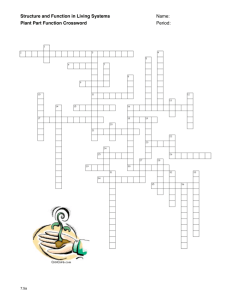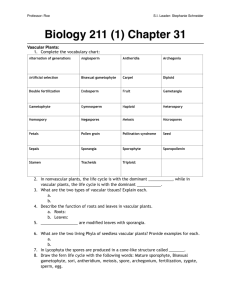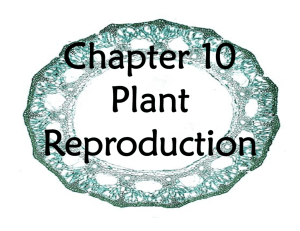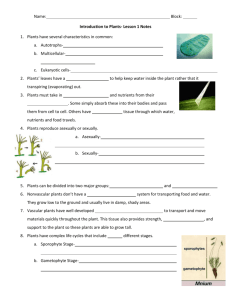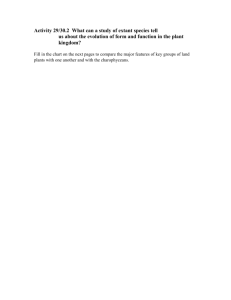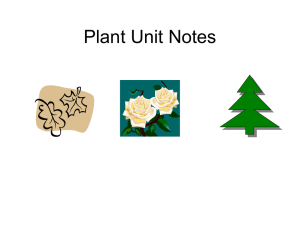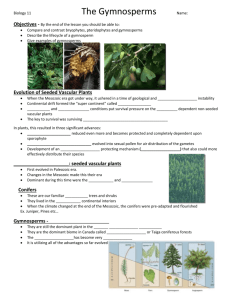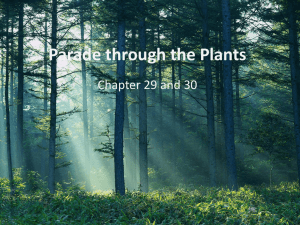Inquiry into Life Twelfth Edition
advertisement
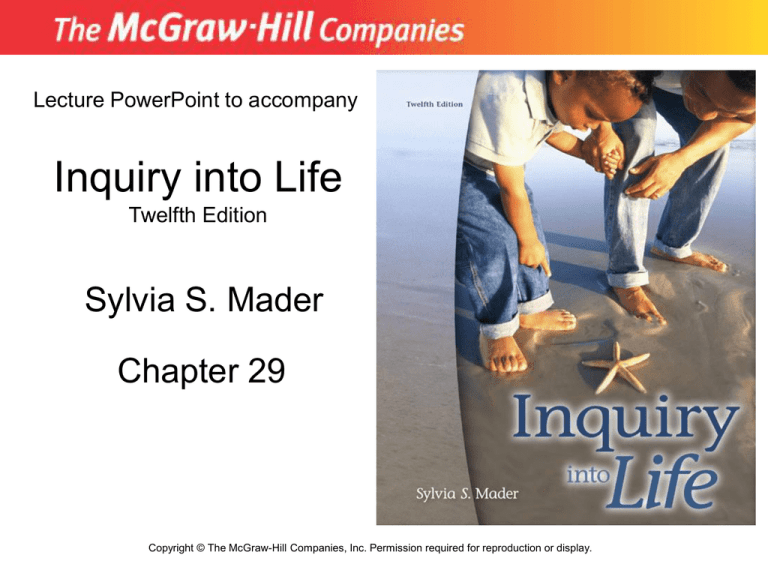
Lecture PowerPoint to accompany Inquiry into Life Twelfth Edition Sylvia S. Mader Chapter 29 Copyright © The McGraw-Hill Companies, Inc. Permission required for reproduction or display. 29.1 Evolutionary History of Plants • Plants evolved from algae over 500 million years ago • Characteristics plants and algae share – Contain chlorophyll a and b and accessory pigments – Store excess carbohydrates as starch – Have cellulose in their cell walls • Biochemical evidence shows plants are most closely related to stonewarts, a type of green algae 29.1 Evolutionary History of Plants • Four Major Events in Evolution of Plants – Development of embryo protection – Development of vascular tissue – Development of seeds – Development of flowers Evolutionary History of Plants 29.1 Evolutionary History of Plants • Alternation of Generations – All plants have a life cycle that included the alternation of generations • Sporophyte (2n) • Gametophyte (n) – Plants differ as to which generation is dominant (most conspicuous) Alternation of Generations Reproduction in the Size of the Gametophyte 29.2 Nonvascular Plants • Nonvascular plants lack true roots, stems, and leaves – By definition, roots, stems, and leaves have vascular tissue • The gametophyte generation is dominant • Three divisions – Hornworts – Liverworts – Mosses 29.2 Nonvascular Plants • Liverworts – Two basic types: “leafy” and those with a flat, lobed thallus – Marchantia- thallus type • • • • Smooth upper surface Lower surface has many rhizoids which extend into soil Reproduce both sexually and asexually Asexual reproduction by gemmae- groups of cells that detach and form new thallus • Sexual reproduction by gametophores- structures that produce gametes Liverwort, Marchantia 29.2 Nonvascular Plants • Mosses – Found all over the world – Mosses become dormant if the environment becomes dry – Most mosses can reproduce asexually by fragmentation in addition to sexual reproduction Moss Life Cycle, Polytrichum sp. 29.2 Nonvascular Plants • Adaptations and Uses of Nonvascular Plants – Can live on bare rock, fences, cracks of sidewalks • Selective advantage to being small and simple – Help convert rocks to soil – Peat moss • Used as fuel • Holds water • Used in gardens to improve soil 29.3 Seedless Vascular Plants • Seedless vascular plants include whisk ferns, club mosses, horsetails, and ferns • The sporophyte is the dominant generation • Vascular tissue – Xylem • Conducts water and minerals up from the soil – Phloem • Transports organic nutrients between parts of the plant • Seedless vascular plants formed the swamp forests of Carboniferous period The Carboniferous Period 29.3 Seedless Vascular Plants • Whisk FernsPsilophyta – Arial stem with many forks • Attached to rhizomeunderground stem • No leaves, photosynthesis occurs in stems – Independent gametophyte found underground 29.3 Seedless Vascular Plants • Club Mosses – Rhizome sends up aerial stems • Scale-like leaves – Some are epiphytes • Live on trees but do not parasitize them 29.3 Seedless Vascular Plants • Horsetails – Moist habitats world wide – Rhizome produces aerial stems – In some species, whorls of side-branches come off the main stem at regions called nodes – Leaves are scale-like – Cones are at tips of stems in most – Have silica deposited in cell walls 29.3 Seedless Vascular Plants • Ferns – Most abundant in warm, moist, tropical regions – Leaves are called fronds • Immature leaves are called fiddleheads • Grow from rhizome – Dominant sporophyte stage • Produces wind-blown spores – Spore germinates and forms small gametophyte • Independent from the sporophyte • Swimming sperm produced by antheridia • Fertilization occurs in archegonia Fern Life Cycle Fern Diversity 29.4 Seed Plants • Gymnosperms and Angiosperms – Seeds contain a sporophyte embryo and stored food within a protective coat • This allows an embryo to survive during long periods of dormancy 29.4 Seed Plants • Gymnosperms – Exhibit heterospory • Two types of spores- produce two types of gametophytes, male and female • Pollen grains- male gametophyte • Pollination-deposition of pollen on a female gametophyte • Pollen tube-sperm pass through pollen tube to reach ovule – No water required as it is in previous groups • Female gametophyte develops within ovule Pine Life Cycle 29.4 Seed Plants • Gymnosperms – Conifers are the most familiar gymnosperms • Pines, spruces, firs, cedars, hemlocks, redwoods, and cypress • Adaptations and Uses of Conifers – Adapted to cold, dry weather – Pollen cones and seed cones are adaptations to land – Needle-shaped leaves have small surface area to decrease water loss • Also have a thick cuticle and recessed stomata – Wood is used in construction and for making paper – Resins are used for production of chemicals Conifers 29.4 Seed Plants • Other Gymnosperms – Cycads • Resemble palms or ferns • Pollen or seed cones grow on top of long vertical stem • Plentiful in Mesozoic era at the time of dinosaurs – Gingkoes • Only one surviving species-Gingko biloba, the maidenhair tree • Female trees produce fleshy seeds that give off a foul odor – Male trees are preferred for ornamental planting – Gnetophytes • Ephedra is only species in N. America • Adapted to hot temperatures Other Gymnosperms 29.4 Seed Plants • Angiosperms – Angio (vessel), sperm (seed) – There are more known species of angiosperms than all other types of plants combined – Live in all types of habitats – Seed develops from an ovule within an ovary • Ovary becomes the fruit – Two classes: Monocots and Eudicots Flower Diversity 29.4 Seed Plants • The Flower – Flower parts • • • • Receptacle: tip of stalk that bears flowers Sepals: modified leaves that protect bud Petals: modified leaves, may be colorful Stamens: male reproductive structures – Anther: pollen production – Filament • Carpels: female reproductive structures – Stigma: for reception of pollen – Style – Ovary: ovule production Generalized Flower Flowering Plant Life Cycle 29.4 Seed Plants • Life cycle, Adaptations, Uses of Flowering Plants – Pollination can be by wind, water, insects, and other animals such as bats – Fruits, the final product of a flower aids in the dispersal of seeds. Fruits


